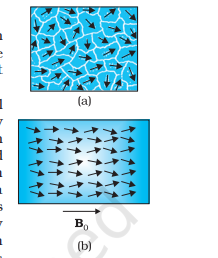MAGNETISM AND MATTER
1/16
Earn XP
Description and Tags
Name | Mastery | Learn | Test | Matching | Spaced |
|---|
No study sessions yet.
17 Terms
Bar Magnet
It has 2 equal and opposite poles
When freely suspended, it orients itself along the geographic north and south
When a bar magnet is cut into 2 pieces, it forms 2 magnets with the north and south pole
There is no magnetic monopole (isolated poles cannot exist)
When a bar magnet is cut laterally, its pole strength decreases and when it is cut transversely its pole strength remains the same
Magnetic Moment
m = NIA
m = p x l (p-pole strength,l=length)
Magnetic Field Lines
Imaginary lines that represent the magnetic field around a magnet
Properties of Magnetic Field Lines
They form continuous curves that originate from the north pole and ends at south pole outside and it goes from south pole to north pole inside
They never intersect
They are closer together in areas of stronger magnetic field and spread out in areas of weaker magnetic field
The density of magnetic field lines is proportional to the strength of the magnetic field (greater the number of field lines per unit area, stronger the magnetic field)
If the magnetic field lines are parallel, then the magnetic field is uniform
The direction of the magnetic field is given by the tangent to the field lines at that point
Magnetic field due to a Bar Magnet as a Solenoid
At an axial point,
B = (µₒ/4π)(2m/r³)
At an equatorial point,
B = (-µₒ/4π)(m/r³)
Dipole in a uniform magnetic field
𝜏 = mxB = mbsinθ
U = -m.B = mbcosθ
Special Cases:
If θ = 0º:
𝜏 = 0
U = -mB
Stable
If θ = 90º:
𝜏 = mb
U = 0
If θ = 180º:
𝜏 = 0
U = mb
Unstable
Dipole Analogy of Electrostatics vs Magnetism

Gauss Law for Magnetism
The closed integral of the magnetic field over a surface is zero
∲B.dA = 0
This indicates the non-existence of magnetic monopoles
The net magnetic flux through any closed surface is zero
Magnetisation (M)
Net magnetic moment acquired by a sample per unit volume when it is placed in a magnetic field
M = mnet/V
Magnetic Field Intensity (H)
It is defined as the ratio of magnetic field induction to the permeability of the medium
H = B/µ
In a solenoid,
H=nI
Unit - A/m
Relation between B, H and M
Bₘ = µₒM
B = µₒ(H+M)
B = µH
Magnetic Susceptibility (χ)
It is the ratio of magnetisation to the magnetic field intensity
χ = M/H
Magnetic Permeability
The ability of a material to become magnetised
µᵣ = 1+χ
µ = µᵣµₒ
µᵣ (relative permeability - the ratio of permeability of medium to the permeability of free space)
Classification of Materials
Diamagnetic
Paramagnetic
Ferromagnetic
Diamagnetic Materials
These materials exhibit negative magnetization, i.e., the molecules align opposite the aligned magnetic field.
Diamagnetic materials have filled orbitals.
They have negative susceptibility: χ < 0
Since χ < 0, M is opposite to H.
The relative permeability of diamagnetic substances μr < 1.
μ < μ₀.
When a diamagnetic material can move in an external magnetic field, it goes from stronger to weaker regions.
When a diamagnetic material is placed in an external magnetic field and cannot move, the field lines expel out of it.
A diamagnetic material will be weakly repelled in the presence of an external field.
Superconducting materials (materials that offer 0 resistance) have their susceptibility as -1, then B will be 0. Hence superconductors are diamagnetic and repel all magnetic field lines out of it.
Examples: Bismouth, Cu, Pb, N₂, Si, H₂O, NaCl.

Paramagnetic Materials
In the presence of an external field, the molecules orient themselves along the direction of the field.
They tend to move from weaker to stronger regions of the magnetic field.
They are very weakly attracted when placed in a magnetic field.
The magnetic field lines will pass through (converge/concentrate) a paramagnetic material.
The susceptibility of the paramagnet is greater than zero: χ > 0
μr > 1
μ > μ₀As temperature increases, the molecules have thermal agitation, so their net magnetic moment decreases. Hence, the susceptibility of a paramagnet depends on temperature.
χ ∝ 1/T (For paramagnets)Examples: Al, Na, Ca, O₂, CuCl₂

Ferromagnetic Materials
Ferromagnetic materials are paramagnets and they form domains.
Domains are groups of atoms/molecules that behave as a single unit.
The susceptibility of ferromagnetic materials is very high:
χ ≫ 0
μr ≫ 1
μ ≫ μ₀As temperature increases, the domains will break, and the ferromagnet becomes a paramagnet.
Ferromagnets are classified as:
Hard Ferromagnet: Retain magnetic property even after removing from the external field.
Soft Ferromagnet: Does not retain the magnetic property.
Examples:
Hard Ferromagnet: Alnico (Alloy), Loadstone
Soft Ferromagnet: Fe, Ni, Co, Gadolinium
